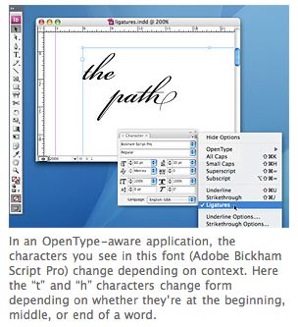Why Use OpenType Fonts?
 by David Blatner
by David Blatner
O
ne
of the oldest myths in desktop publishing is “never
use TrueType fonts for professional publishing.”
Perhaps that was true in the early 90’s, but there’s
no reason to avoid them now. However, there’s an even
better type of font format you should be using:
OpenType. OpenType fonts are great for a number of
reasons:
They
have just one file per font, eliminating the need to
manage separate screen and printer font files.
They’re cross-platform — you can
use the same font on both Mac and PC.
They
can contain thousands of characters, so you no longer
need separate expert fonts.
They
can contain intelligent characters, such as automatic
fractions, special characters, and character pairs
that change depending on where they appear in a word
(such as a swash character).
They
allow OpenType-aware applications to follow special
instructions inside the font called glyph variants
and automatically swap out characters when relevant.
For example, in a script typeface, the application
would be smart enough to use one kind of “t” when it
appears at the beginning of a word and a different
version when it’s in the middle of a word (so that it
smoothly attaches to the letters around it).
Applications that are not OpenType-aware — such as
older versions of QuarkXPress or PageMaker — will
still work with OpenType fonts, but without the
advanced glyph features and intelligence.
Adobe Phasing Out "PostScript" Type 1 Fonts
Adobe stopped developing new Type 1 fonts in 1999, and introduced its first OpenType fonts in 2000. As we converted our type library to OpenType, we made the corresponding Type 1 fonts much less prominent on our web site. Now that we have our whole library in OpenType, people really have to go out of their way to get Type 1 fonts. This has been true for several years now. Continued here...